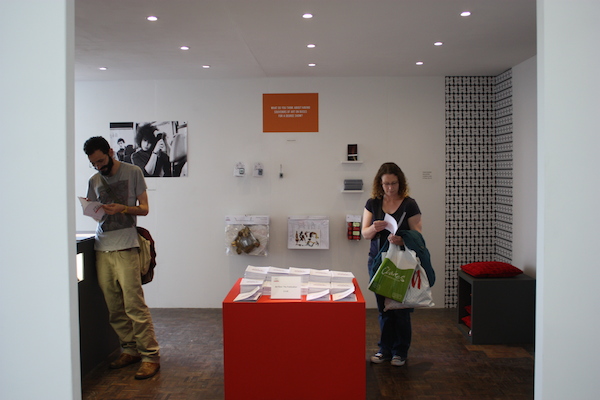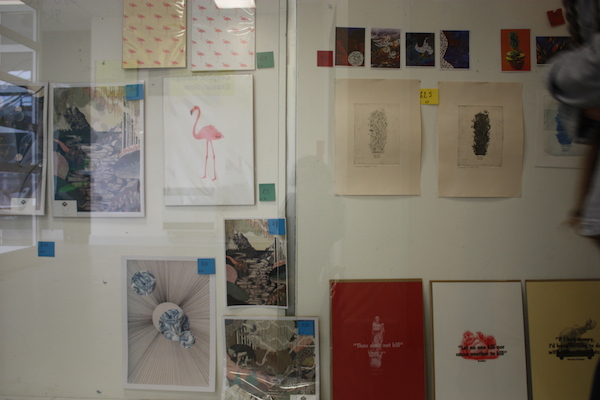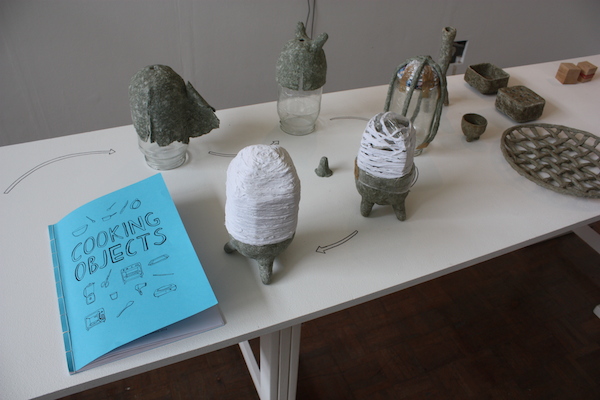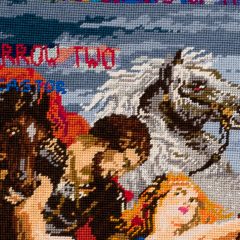[Our UK correspondent, Katie, reflects on the plight of the graduating art student; she discusses how these challenges are reflected in a show of matriculating students’ work. — the Artblog editors]
An institution like a university provides its students access to an extraordinary range of contacts, information, resources, and tools. One difficulty is that the culture residing within its walls can also tend to reinforce a belief that such structures are essential to facilitate, showcase, and validate cultural production. The yearly Graduate Show at the University of Brighton sees a crop of students just about to step outside of this protective atmosphere, at a moment when they will have to consider how the work they have been pursuing might find a place in the wider world.
Working around financial constraints
This question has become rather more pressing in recent years; today’s students find themselves in a far harsher financial position than previous generations since the controversial introduction of and subsequent increase in tuition fees in the UK, whose economical and practical benefits have been widely questioned. They will also find themselves without the space, resources, and peer group that have shaped their university experience.

The university workspace is brought into the gallery in “They Just Seem to be Going Backwards and Forwards,” by sculpture students Alexander Paveley and Anthony Gartland. One wall of the studio gallery is cut through, with a special glass mounted in it that alternates between showing a projected film and revealing the theatrically-lit workshop behind.
The video shows an amateur string group rehearsing in the workshop itself, the camera panning smoothly as they play. When, in the audio, the conductor stops the group, the video also stops, and the workshop appears. “Everything shown in here is made in there,” artist Alexander Paveley explained to me. “It’s like a rehearsal.” He pointed out the workshop aesthetic of much of the other work in the department’s show–a visible reminder of the shaping influence exerted by their environment.

The device used in Paveley and Gartland’s work was made possible by the donation of thousands of pounds’ worth of switchable glass, which is a special glass that only becomes transparent when a current is passed through it. In its opaque state, it acts as a screen for a back projection. The glass was donated by a company called Magic Glass, which, when approached with the proposal, was pleased to see the glass being used in new ways. The company transported it all the way from Manchester at no charge. Paveley and Gartland have become adept at securing themselves significant donations from generous benefactors, including thousands of books and large amounts of wood.
Pricing paradox

This year’s Fine Art: Critical Practice students secured an interesting arrangement for their final show with the Brighton and Hove city bus company. They showed performances, installations, and publications on the city’s public transport to an audience that may not have been expecting such an encounter on their daily journey. Their contribution to the Graduate Show, however, took the form of a souvenir shop, with records and tasters of the event available to be taken home for a decent price.
Work on sale ranged from posters and postcards to specially-designed wallpaper that appeared on a bus window, DIY miniature Damien Hirst kits, and Art Fare sticker sets. This amusing poster (above) is a call-centre-inspired script for selling Art Fare, complete with objection-handling and motivational rhetoric–inspired, perhaps, by the long-standing Brighton joke that the Graduate Show is the best place to see next year’s crop of call centre employees.
The discomfiting focus on money and profit in the show sat in uneasy harmony with the prints and editions labelled with prices elsewhere in the Graduate Show, students’ financial woes a tangible anxiety.

DIY (Do It Yourself)
The necessity of shops to provide for our aesthetic needs and desires is called into question by Design and Craft student Julian Komosa in his “Cooking Objects” project. He presents a distinctive and beautiful way of using household items and rubbish to create useful objects, like lamps, bowls, and candlesticks.
Several other design projects focused on ways that rubbish can be reshaped into something useful, in keeping with the spirit of the times; what sets Komosa’s project apart is the emphasis on showing others how to make these objects. The artist’s mottled, green-grey collection is shown along with a cookbook detailing the objects’ production.

In need of a lamp myself, I asked Komosa where I might buy this cookbook. He told me that he was hoping that someone might publish it, but failing that, perhaps he might go down the self-publishing route. It seems possible that, particularly in the modern context of copyright issues and information-sharing, it might be more in keeping with the DIY ethos of the project to go down that route rather than depending on a publisher.
Though a workshop may hold the rehearsal for a show, university study is by no means a rehearsal for the outside world. Having been trained in a certain way of working, which has embedded in it some of the hierarchical structure of the institution, these students must now step back and consider how their work might find a place outside of that structure.






